June 29, 2009, Las Vegas, Nevada - Interior Secretary Ken Salazar and Senator Harry Reid (D-NV) announced 'fast-track' policies for solar energy development on federal lands in the Southwest. The government will help companies build solar farms in the desert by pre-qualifying huge swaths of federal land for development.
SEND COMMENT LETTER >>here.
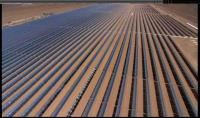
The Bureau of Land Management (BLM) will designate tracts of U.S. public lands as potential zones for utility-scale solar energy development, as well as open new solar energy permitting offices which will speed environmental reviews of industry applications. The streamlined review and approval process would take one year, instead of three to four years, Interior spokesman Frank Quimby said.
"The Secretary of the Interior proposes to withdraw approximately 676,048 acres of public lands from settlement, sale, location, or entry under the general land laws, including the mining laws, on behalf of the Bureau of Land Management (BLM) to protect and
preserve solar energy study areas for future solar energy development. This notice segregates the lands for up to 2 years from surface entry and mining while various studies and analyses are made to support a final decision on the withdrawal application," says the notice on the Federal Register, June 30, 2009.
These Solar Energy Study Areas, 24 tracts of Bureau of Land Management-administered land in California, Nevada, Arizona, New Mexico, Utah, and Colorado, would be fully evaluated for their environmental and resource suitability for large-scale solar energy production. The objective is to provide landscape-scale planning and zoning for solar projects on BLM lands, cutting out much of the obstacles (such as public comment?) to permitting and siting solar development. 31 of the 35 projects already in the works in the study areas are in the California desert.
Those areas selected would be available for projects capable of producing 10 or more megawatts of electricity for distribution to customers through the transmission grid system. Companies that propose projects on that scale in areas already approved for this type of development would be eligible for priority processing.
Secretary Salazar and Senator Reid also announced the opening of a new Interior renewable energy coordination office (RECO) in Nevada, the first of four, with the others located in Arizona, California, and Wyoming to expedite processing of applications.
The Solar Energy Study Areas will be included in the Solar Programmatic Environmental Impact Statement, or PEIS, which will be expanded to include an in-depth analysis of the potential impacts of utility-scale solar energy development on public lands. Additional federal funding under the American Recovery and Reinvestment Act will be given to the BLM to increase efficiency of processing applications. The BLM will also continue to accept new applications both within and outside of the Solar Energy Study Areas. Companies wishing to locate within one of these energy zones would be able to use the environmental impact studies already undertaken by BLM, in a collaborative effort with the Department of Energy, thus reducing their time and expense at having to undertake their own separate studies which is a requirement of the National Environmental Policy Act.
For a period of 90 days from June 30, 2009, public comments, suggestions, or
objections in connection with the proposed withdrawal of land for Solar Energy Study Areas may be sent to the BLM Director, 1849 C Street NW. (WO350), Washington, DC, 20240. Public hearings may also be requested. This evaluation is expected to be completed in late 2010. We called BLM, and apparently this comment period is only for whether these public lands should be withdrawn for energy development, or not.
Confusingly, a second comment period involving the actual Solar Energy Study Areas themselves -- their resources, is only 30 days long, ending July 30, 2009. This involves the wildlife - bighorn sheep, tortoises, lizards, birds, as well as rare plants, cultural resources, archaeology, visual impacts, and everthing else that will be impacted by energy projects on desert lands. Comments on the Solar Energy Study Areas may be submitted electronically through the public comment form on the Solar Energy Development Programmatic EIS Information Center Web site at http://solareis.anl.gov. Written comments can also be mailed to Solar Energy PEIS, Argonne National Laboratory, 9700 S. Cass Avenue -- EVS/900, Argonne, IL 60439. This comment period is ridiculously short to cover such a giant amount of land across the West. We recommend writing the BLM director and requesting an extension to this comment period.
BREAKING NEWS: July 27, 2009
The Department of Energy and the Bureau of Land Management announce the extension of the public scoping period regarding solar energy study areas to be analyzed in the
Solar Energy Development PEIS. The new deadline for public scoping comments is September 14, 2009.
The Notice of Extension of Public Comment Period for Programmatic Environmental Impact Statement to Develop and Implement Agency-Specific Programs for Solar Energy
Development was published in the Federal Register on Monday, July 27, 2009. It is available on the Solar Energy Development PEIS Web site at http://solareis.anl.gov.
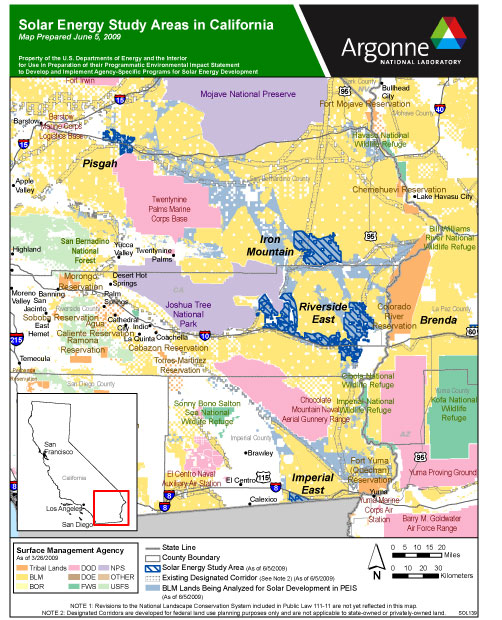
^Dark hatched blue areas are newly designated Solar Energy Study Areas, conveniently in places already chosen by solar energy companies we note. These applications will now be given priority. Areas in blue are future potential Solar Energy Study Areas.
(http://solareis.anl.gov/documents/maps/study areas/Solar_Study_Area_CA_Ltt_6-09.pdf)
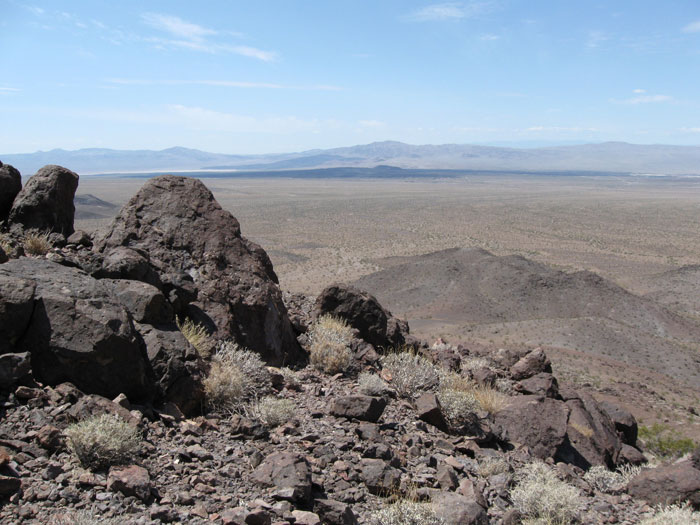
^View from Cady Mountains proposed wilderness: Pisgah Crater and the valley where an 8,000-acre solar dish energy development is planned, along Highway 40 east of Bart stow, as well as old Route 66.
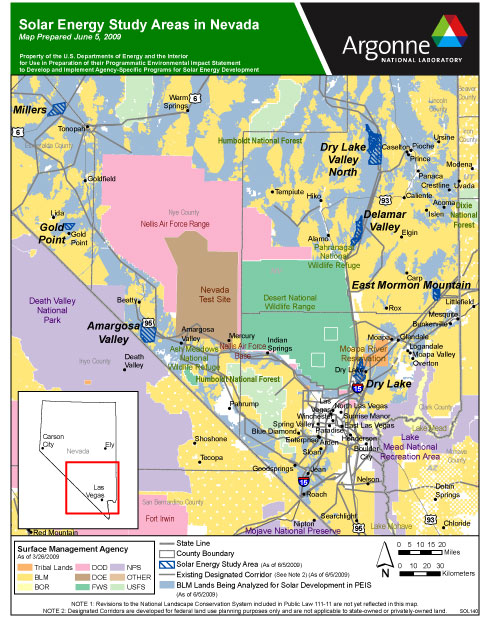
^For Nevada, Reid apparently decided to give away most of the lowlands for potential future Solar Energy Study Areas, in light blue. Dark hatched blue areas are prioritized.
(http://solareis.anl.gov/documents/maps/study areas/Solar_Study_Area_NV_Ltt_6-09.pdf)
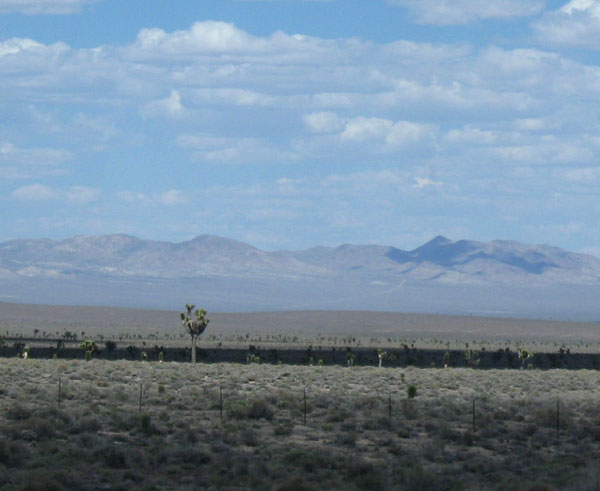
^Wide open desert with Joshua trees near Goldfield, Nevada, within potential future Solar Energy Study Areas.
The highest priority will be given to 13 projects that are furthest along in planning and will be able to meet a December 2010 deadline for funding, including such projects as:
- Stirling Energy's Solar One near Barstow
- Solar Two in El Centro
- Britesource near Primm, Nevada
- 3 Chevron projects: one near Barstow and two along Interstate 10 between Desert Center and Blythe
- First Solar project in Desert Center
- Nextera near Blythe
- Solar Millennium in Ridgecrest
The BLM will begin site-specific environmental reviews for two major projects in Nevada: the NextLight Silver State South array is planned to produce 267 megawatts in Ivanpah Valley near Primm; and the NextLight Silver State North would produce about 140 megawatts.
Currently BLM has received about 470 renewable energy project applications. Those include 158 active solar applications, covering 1.8 million acres. The BLM will continue to process existing renewable energy applications, both within and outside of the solar energy study areas.
Joan Taylor, California-Nevada desert energy chairwoman for The Sierra Club, called the declaration "a knife through the heart of the desert."
But many in the localized renewable energy movement decry the large national environmental organizations that opened the door to this land grab. The Department of Energy's own studies revealed long ago that 190% of our electricity needs can be met within the built environment, using thin film PV on existing rooftops and brownfields -- without harming our water supply and open spaces. And this could be much faster and less expensive than the corporate industrial model. Instead of supporting clean, democratic, and reliable power production and conservation, we may now have the destruction of much of the Mojave Desert and other wildlands in the West.
Pending Solar Company Applications
Within the new Solar Energy Study Areas these companies have applications with BLM (note that not all Study Areas have applications yet):
Arizona:
Brenda - no applications.
Bullard Wash - no applications.
Gillespie - no applications.
California:
Iron Mountain - Leopold Companies (43,985 acres), Boulevard Associates (709 acres), Ewindfarm, Inc. (two projects - 12,960 acres and 18,557 acres).
Pisgah - Stirling Energy (5,017 acres, 3,460 acres, and 5,400 acres), enXco (3,691 acres).
Riverside East - Solar Millenium ( 3,691 acres, 3,101 acres, and 8,626 acres), Optisolar (First Solar) (14,742 acres and 7,237 acres), Genesis - McCoy (7,753 acres), Chuckwalla (4,091 acres), NextEra Genesis (4,436 acres), Altera (8,703 acres and 6,618 acres), enXco (2,065 acres), enXco - Ford Dry Lake (15,921 acres), enXco - Ford Dry Lake (20,604 acres), enXco 1 (1,051 acres), Solel - McCoy (8,589 acres), Solel - Desert Lily (7,384 acres), Bullfrog - Maria Vista (22,844 acres).
Colorado:
Antonito Southwest - no applications.
De Tilla Gulch - Optisolar (2,100 acres).
Fourmile East - no applications.
Los Mogotes East - no applications.
New Mexico:
Afton - enXco (3,000 acres).
Mason Draw - no applications.
Red Sand - no applications.
Nevada:
Armargosa Valley (north of Big Dune to Beatty)- Cogentrix (22,400 acres).
Dry Lake (SNDO 3) - Cogentrix (11,584 acres and 2,012 acres), Optisolar (First Solar) (5,500 acres), NV Energy (1,959 acres), Power Partners Southwest LLC (1,752 acres).
Goldpoint (BNDO 2) - no applications.
Millers (BMDO 1) - no applications.
Utah:
Escalante Valley - no applications.
Milford Flats South - no applications.
Wah Wah Valley - no applications.
Barons of the Land Rush
“President Obama’s comprehensive energy strategy calls for rapid development of renewable energy, especially on America’s public lands,” said Secretary Salazar. “This environmentally-sensitive plan will identify appropriate Interior-managed lands that have  excellent solar energy potential and limited conflicts with wildlife, other natural resources or land users. The two dozen areas we are evaluating could generate nearly 100,000 megawatts of solar electricity. With coordinated environmental studies, good land-use planning and zoning and priority processing, we can accelerate responsible solar energy production that will help build a clean-energy economy for the 21st century.”
excellent solar energy potential and limited conflicts with wildlife, other natural resources or land users. The two dozen areas we are evaluating could generate nearly 100,000 megawatts of solar electricity. With coordinated environmental studies, good land-use planning and zoning and priority processing, we can accelerate responsible solar energy production that will help build a clean-energy economy for the 21st century.”

“I want to thank Secretary Salazar for his commitment to renewable energy, and for being here in Nevada today,” said Reid. "This is the Secretary's second visit to Nevada to announce key renewable energy initiatives that will help make Nevada the blueprint for everything that’s right about the future of our nation’s energy policy. We’ve got sunny skies, strong winds, and land that when used properly, will allow us to lead the nation’s children into a cleaner, more efficient, and more profitable tomorrow.”
BLM news >>here.
Story in the San Bernardino Press-Enterprise >>here.
Solar Land Rush - in Nevada, Goldman Sachs subsidiary Cogentrix Energy has filed lease claims on 35,996 acres within solar energy study zones on BLM land. New York Times, Green Inc. story >>here.
More on Goldman Sachs and the possible coming renewable energy bubble at Rolling Stone, by Matt Taibbi >>here.
HOME.....'A Better Way'.....Sample Comment Letter to Send
